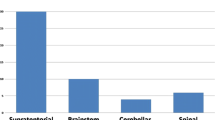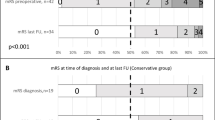Abstract
Cavernous malformations (CMs) located at the foramen of Monro (FM) are relatively rare benign vascular malformations. Knowledge of FM CM is poor. The aims of this study were to describe the incidence, clinical presentation, radiological features, surgical approaches, and neurological outcomes for FM CM patients and to discuss the treatment strategy for this disease. We present a series of nine FM CM patients (four males, five females; mean age 29.3 years) who were treated at a single neurosurgical center. FM CM accounted for 0.56% of the entire series of the central nervous system (CNS) CMs. Headache accompanied by nausea and vomiting was the most common initial symptom (55.6%). The mean preoperative Karnofsky Performance Scale (KPS) score was 84.4 (range 70–100). In all but one patient, the lesions were surgically resected. Postoperatively, two patients developed obstructive hydrocephalus, and one experienced motor aphasia and right hemiparesis. At the time of discharge, the KPS score improved to a mean of 88.9. Follow-up period after diagnosis was 18 to 131 months (mean 69.7 months); all the patients were considered to be in excellent clinical condition. FM CMs are rare and challenging lesions; they have a female predilection. The most common clinical manifestations of FM CM are the symptoms of mass effect. The seizure risk of FM CMs seems to be significantly lower than that of general intraventricular CMs. Early surgical intervention should be offered to symptomatic cases, and gross total resection is associated with favorable neurological outcomes.





Similar content being viewed by others
References
Lee B, Choi C, Lee C (2012) Intraventricular cavernous hemangiomas located at the foramen of Monro. J Korean Neurosurg Soc 52(2):144–147. https://doi.org/10.3340/jkns.2012.52.2.144
Britt RH, Silverberg GD, Enzmann DR, Hanbery JW (1980) Third ventricular choroid plexus arteriovenous malformation simulating a colloid cyst. Case Report. J Neurosurg 52(2):246–250. https://doi.org/10.3171/jns.1980.52.2.0246
Matsumoto Y, Kurozumi K, Shimazu Y, Ichikawa T, Date I (2016) Endoscope-assisted resection of cavernous angioma at the foramen of Monro: a case report. Spring 5(1):1820. https://doi.org/10.1186/s40064-016-3538-x
Chen C, Leu C, Jan Y, Shen C (2006) Intraventricular cavernous hemangioma at the foramen of Monro: case report and literature review. Clin Neurol Neurosurg 108(6):604–609. https://doi.org/10.1016/j.clineuro.2005.04.004
Pozzati E, Gaist G, Poppi M, Morrone B, Padovani R (1981) Microsurgical removal of paraventricular cavernous angiomas. Report of two cases. J Neurosurg 55(2):308–311. https://doi.org/10.3171/jns.1981.55.2.0308
Harbaugh RE, Roberts DW, Fratkin JD (1984) Hemangioma calcificans. Case report. J Neurosurg 60(2):417–419. https://doi.org/10.3171/jns.1984.60.2.0417
Ogawa A, Katakura R, Yoshimoto T (1990) Third ventricle cavernous angioma: report of two cases. Surg Neurol 34(6):414–420. https://doi.org/10.1016/0090-3019(90)90246-L
Katayama Y, Tsubokawa T, Maeda T, Yamamoto T (1994) Surgical management of cavernous malformations of the third ventricle. J Neurosurg 80(1):64–72. https://doi.org/10.3171/jns.1994.80.1.0064
Kaim A, Kirsch E, Tolnay M, Steinbrich W, Radu EW (1997) Foramen of Monro mass: MRI appearances permit diagnosis of cavernous haemangioma. Neuroradiology 39(4):265–269. https://doi.org/10.1007/s002340050405
Crivelli G, Dario A, Cerati M, Dorizzi A (2002) Third ventricle cavernoma associated with venous angioma. Case report and review of the literature. J Neurosurg Sci 46(3-4):127–130
Suess O, Hammersen S, Brock M (2002) Intraventricular cavernoma: unusual occurrence in the region of the foramen of Monro. Br J Neurosurg 16(1):78–79. https://doi.org/10.1080/0268869012011430
Longatti P, Fiorindi A, Perin A, Baratto V, Martinuzzi A (2006) Cavernoma of the foramen of Monro. Case report and review of the literature. Neurosurg Focus 21(1):1–4. https://doi.org/10.3171/foc.2006.21.1.14
Sato K, Oka H, Utsuki S, Shimizu S, Suzuki S, Fujii K (2006) Neuroendoscopic appearance of an intraventricular cavernous angioma blocking the foramen of Monro—case report. Neurol Med Chir (Tokyo) 46(11):548–551. https://doi.org/10.2176/nmc.46.548
Prat R, Galeano I (2008) Endoscopic resection of cavernoma of foramen of Monro in a patient with familial multiple cavernomatosis. Clin Neurol Neurosurg 110(8):834–837. https://doi.org/10.1016/j.clineuro.2008.05.011
Kivelev J, Niemela M, Kivisaari R, Hernesniemi J (2010) Intraventricular cerebral cavernomas: a series of 12 patients and review of the literature. J Neurosurg 112(1):140–149. https://doi.org/10.3171/2009.3.JNS081693
Bhatia S, Kapoor AK, Gupta R, Sahni T (2013) Cavernous hemangioma located at the foramen of Monro: radiopathological correlation. Indian J Radiol Imaging 23(3):202–204. https://doi.org/10.4103/0971-3026.120259
Patibandla MR, Thotakura AK, Panigrahi MK (2014) Third ventricular cavernous malformation: an unusual lesion. Br J Neurosurg 28(1):110–112. https://doi.org/10.3109/02688697.2013.812183
Faropoulos K, Panagiotopoulos V, Partheni M, Tzortzidis F, Konstantinou D (2015) Therapeutic management of intraventricular cavernoma: case series and review of the literature. J Neurol Surg A Cent Eur Neurosurg 76(03):233–239. https://doi.org/10.1055/s-0034-1389093
Muzumdar D, Avinash KM, Ramdasi R (2015) Cavernoma of the septum pellucidum in the region of foramen of Monro. Neurol India 63(1):68–71. https://doi.org/10.4103/0028-3886.152641
Winslow N, Abode-Iyamah K, Flouty O, Park B, Kirby P, Howard MR (2015) Intraventricular foramen of Monro cavernous malformation. J Clin Neurosci 22(10):1690–1693. https://doi.org/10.1016/j.jocn.2015.03.043
Shirvani M, Hajimirzabeigi A (2017) Intraventricular cavernous malformation: review of the literature and report of three cases with neuroendoscopic resection. J Neurol Surg A Cent Eur Neurosurg 78(03):269–280. https://doi.org/10.1055/s-0036-1594235
Beechar VB, Srinivasan VM, Reznik OE, Sen A, Klisch TJ, Ropper AE, Mandel JJ, Heck KA, Seipel TJ, Patel AJ (2017) Intraventricular cavernomas of the third ventricle: report of 2 cases and a systematic review of the literature. World Neurosurg 105:935–943. https://doi.org/10.1016/j.wneu.2017.06.109
Zabramski JM, Wascher TM, Spetzler RF, Johnson B, Golfinos J, Drayer BP, Brown B, Rigamonti D, Brown G (1994) The natural history of familial cavernous malformations: results of an ongoing study. J Neurosurg 80(3):422–432. https://doi.org/10.3171/jns.1994.80.3.0422
Gross BA, Lin N, Du R, Day AL (2011) The natural history of intracranial cavernous malformations. Neurosurg Focus 30(6):E24. https://doi.org/10.3171/2011.3.FOCUS1165
Chadduck WM, Binet EF, Farrell FJ, Araoz CA, Reding DL (1985) Intraventricular cavernous hemangioma: report of three cases and review of the literature. Neurosurgery 16(2):189–197. https://doi.org/10.1227/00006123-198502000-00011
Maraire JN, Awad IA (1995) Intracranial cavernous malformations: lesion behavior and management strategies. Neurosurgery 37(4):591–605. https://doi.org/10.1227/00006123-199510000-00001
Reyns N, Assaker R, Louis E, Lejeune JP (1999) Intraventricular cavernomas: three cases and review of the literature. Neurosurgery 44(648–654):654–655
Gross BA, Du R (2015) Cerebral cavernous malformations: natural history and clinical management. Expert Rev Neurother 15(7):771–777. https://doi.org/10.1586/14737175.2015.1055323
Tatagiba M, Schonmayr R, Samii M (1991) Intraventricular cavernous angioma. A survey. Acta Neurochir 110(3-4):140–145. https://doi.org/10.1007/BF01400682
Rigamonti D, Drayer BP, Johnson PC, Hadley MN, Zabramski J, Spetzler RF (1987) The MRI appearance of cavernous malformations (angiomas). J Neurosurg 67(4):518–524. https://doi.org/10.3171/jns.1987.67.4.0518
Kumar GSS, Poonnoose SI, Chacko AG, Rajshekhar V (2006) Trigonal cavernous angiomas: report of three cases and review of literature. Surg Neurol 65(4):367–371. https://doi.org/10.1016/j.surneu.2005.09.015
Atlas SW, Grossman RI, Gomori JM, Hackney DB, Goldberg HI, Zimmerman RA, Bilaniuk LT (1987) Hemorrhagic intracranial malignant neoplasms: spin-echo MR imaging. Radiology 164(1):71–77. https://doi.org/10.1148/radiology.164.1.3588929
Kondziolka D, Bernstein M, Resch L, Tator CH, Fleming JF, Vanderlinden RG, Schutz H (1987) Significance of hemorrhage into brain tumors: clinicopathological study. J Neurosurg 67(6):852–857. https://doi.org/10.3171/jns.1987.67.6.0852
Sze G, Krol G, Olsen WL, Harper PS, Galicich JH, Heier LA, Zimmerman RD, Deck MD (1987) Hemorrhagic neoplasms: MR mimics of occult vascular malformations. AJR Am J Roentgenol 149(6):1223–1230. https://doi.org/10.2214/ajr.149.6.1223
Hakyemez B, Erdogan C, Oruc E, Aker S, Aksoy K, Parlak M (2007) Foramen of Monro meningioma with atypical appearance: CT and conventional MR findings. Australas Radiol 51 Spec No.: B3–B5. doi: https://doi.org/10.1111/j.1440-1673.2007.01784.x
Niiro T, Tokimura H, Hanaya R, Hirano H, Fukukura Y, Sugiyma K, Eguchi K, Kurisu K, Yoshioka H, Arita K (2012) MRI findings in patients with central neurocytomas with special reference to differential diagnosis from other ventricular tumours near the foramen of Monro. J Clin Neurosci 19(5):681–686. https://doi.org/10.1016/j.jocn.2011.06.030
Lunsford LD, Khan AA, Niranjan A, Kano H, Flickinger JC, Kondziolka D (2010) Stereotactic radiosurgery for symptomatic solitary cerebral cavernous malformations considered high risk for resection. J Neurosurg 113(1):23–29. https://doi.org/10.3171/2010.1.JNS081626
Nagy G, Razak A, Rowe JG, Hodgson TJ, Coley SC, Radatz MW, Patel UJ, Kemeny AA (2010) Stereotactic radiosurgery for deep-seated cavernous malformations: a move toward more active, early intervention. Clinical article. J Neurosurg 113(4):691–699. https://doi.org/10.3171/2010.3.JNS091156
Gewirtz RJ, Steinberg GK, Crowley R, Levy RP (1998) Pathological changes in surgically resected angiographically occult vascular malformations after radiation. Neurosurgery 42(738–742):742–743
Steiner L, Karlsson B, Yen CP, Torner JC, Lindquist C, Schlesinger D (2010) Radiosurgery in cavernous malformations: anatomy of a controversy. J Neurosurg 113(16–21):21–22. https://doi.org/10.3171/2009.11.JNS091733
Sheehan J, Ding D, Starke RM (2015) Radiosurgery and cavernous malformations. J Neurosurg 123(4):935–936. https://doi.org/10.3171/2014.10.JNS142305
Raychaudhuri R, Batjer HH, Awad IA (2005) Intracranial cavernous angioma: a practical review of clinical and biological aspects. Surg Neurol 63(4):319–328. https://doi.org/10.1016/j.surneu.2004.05.032
Milligan BD, Meyer FB (2010) Morbidity of transcallosal and transcortical approaches to lesions in and around the lateral and third ventricles: a single-institution experience. Neurosurgery 67:1483–1496. https://doi.org/10.1227/NEU.0b013e3181f7eb68
Pendl G, Ozturk E, Haselsberger K (1992) Surgery of tumours of the lateral ventricle. Acta Neurochir 116(2-4):128–136. https://doi.org/10.1007/BF01540865
Spina A, Gagliardi F, Bailo M, Boari N, Caputy AJ, Mortini P (2016) Comparative anatomical study on operability in surgical approaches to the anterior part of the third ventricle. World Neurosurg 95:457–463. https://doi.org/10.1016/j.wneu.2016.08.073
Gaab MR, Schroeder HW (1998) Neuroendoscopic approach to intraventricular lesions. J Neurosurg 88(3):496–505. https://doi.org/10.3171/jns.1998.88.3.0496
Teo C, Nakaji P (2004) Neuro-oncologic applications of endoscopy. Neurosurg Clin N Am 15(1):89–103. https://doi.org/10.1016/S1042-3680(03)00068-8
Funding
This study was funded by the National Natural Science Foundation of China (81371292) and the “13th Five-Year Plan” National Science and Technology supporting plan (2015BAI12B04).
Author information
Authors and Affiliations
Corresponding author
Ethics declarations
Conflict of interest
The authors declare that they have no conflict of interest.
Ethical approval
This study was approved by the Research Ethics Board of Beijing Tiantan Hospital, Capital Medical University.
Informed consent
Informed consent was obtained from all individual participants who were included in the study.
Rights and permissions
About this article
Cite this article
Wang, C., Zhao, M., Deng, X. et al. Neurosurgical management of cavernous malformations located at the foramen of Monro. Neurosurg Rev 41, 799–811 (2018). https://doi.org/10.1007/s10143-017-0930-0
Received:
Revised:
Accepted:
Published:
Issue Date:
DOI: https://doi.org/10.1007/s10143-017-0930-0




